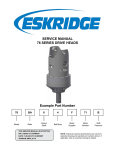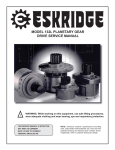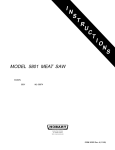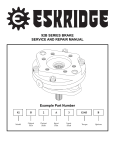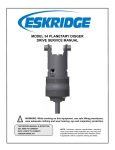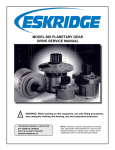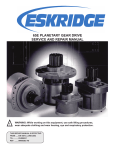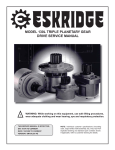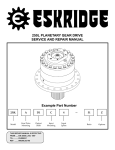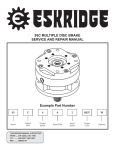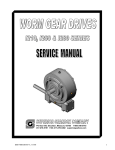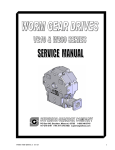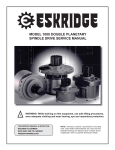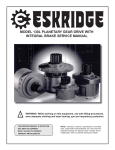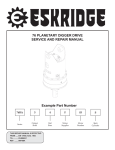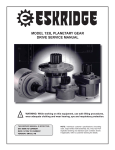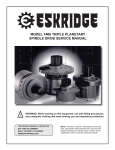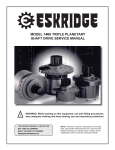Download SERVICE MANUAL
Transcript
65E PLANETARY GEAR DRIVE with integral brake SERVICE AND REPAIR MANUAL ! WARNING: While working on this equipment, use safe lifting procedures, wear adequate clothing and wear hearing, eye and respiratory protection. This service manual is effective From:...... S/N 55013, june 2002 To:............ CURRENT Ref:......... SM65EibD2-Ab 65esinglestageexplodedviewDrawing 2 integralbrakeexplodedDrawing 3 Lubrication & Maintenance Using the chart below, determine an appropriate lubricant viscosity. Use only EP (extreme pressure) or API GL-5 designated lubricants. Change the lubricant after the first 50 hours of operation and at 500 hour intervals thereafter. The gear drive should be partially disassembled to inspect gears and bearings at 1000 hour intervals. Recommended ambient and operating temperatures for conventional and synthetic gear lubricants -50 -25 0 25 50 75 100 125 150 175 200 225 250 F 107 121 C 80W90 conventional 75W90 conventional 85W140 conventional Min Ambient/operating temp Max Operating temp Max Ambient temp 75W90 synthetic 80W140 synthetic -45 -32 -18 -4 10 24 38 52 66 79 93 Note: Ambient temperature is the air temperature measured in the immediate vicintiy of the gearbox. A Gearbox exposed to the direct rays of the sun or other radiant heat sources will operate at higher temperatures and therefore must be given special consideration. The max operating temp must not be exceeded under any circumstances, regardless of ambient temperature. If your unit was specified “shaft up” or with a “-Z” option, a grease zerk was provided in the base housing. For shaft-up operation, the output bearing will not run in oil and must be grease lubricated. Use a lithium based or general purpose bearing grease sparingly every 50 operating hours or at regular maintenance intervals. Over-greasing the output bearing should be avoided as it tends to fill the housing with grease and thicken the oil ESKRIDGE MODEL 65E OIL CAPACITIES Operating Position Oil Capacity Oil Level Single stage Double stage Horizontal Shaft 2.25 pints / 1.1 liters 2.25 pints / 1.1 liters To horizontal centerline of gear drive Vertical Shaft (Pinion Up) 2.5 pints / 1.2 liters 2.5 pints / 1.2 liters To side port on gear drive base Vertical Shaft (Pinion Down) 2.5 pints / 1.2 liters 2.5 pints / 1.2 liters To midway on upper/ primary gear set ESKRIDGE PART NUMBER INTERPRETATION Note: All non custom Eskridge Geardrives are issued a descriptive part number which includes information regarding the Model, means of shaft retention, base style, shaft style, input mounting, input shaft size, overall ratio and various available options. For a detailed breakdown of this information, please refer to Eskridge product specification sheets found at: http://www.eskridgeinc.com/geardrives/gearprodspecs.html Unit Disassembly Procedure 1) 1) Scribe a diagonal line across the outside of the unit from cover/ brake (6) to case (1) before disassembly to assure proper positioning of pieces during reassembly. Rotate the planet gears (10) to check for abnormal noise or roughness in bearings (18) or planet shafts (8). If further inspection or replacement is required, proceed as follows. 2) Drive roll pins (29) into planet shafts (8). 3) Press or drive planet shafts out of carrier (3). 4) Slide planet gears (10) along with planet washers (15) out of primary carrier (3). 5) If planet bearings (18) must be replaced, they may now be removed from primary planet gears (10). 6) Use 1/8 inch pin punch to remove roll pins (27) from planet shafts. 7) Rebuild primary planet carrier assembly in reverse order using any needed new parts. Planet shafts (8) should be installed with chamfered end of 1/8 inch hole toward outside diameter of carrier. This will aid in alignment of holes while inserting roll pins. 2) Remove magnetic pipe plug (32) and drain oil from unit. Maximum drainage occurs when oil is warm. 3) Remove eight cover/brake bolts (24) and lockwashers (27). 4) Lift off cover/brake (6). The input shaft (12) and carrier thrust washer (4) may be lifted out of carrier assembly. 5) Lift primary planet carrier assembly (3,8,10,15,18, & 29) out of case. 6) The output shaft (13) and secondary planet carrier assembly may now be removed as follows: a) The secondary planet carrier (2) spline is a press fit onto output shaft (13) spline. Case (1) should be set on a plate or table with output shaft protruding downward through hole in table. Secondary Planet Carrier Subassembly (Items 2, 5, 7, 9, 14, 15, 19, 22 & 28) b) Loosen but do not remove shaft retaining cap screws (25). NOTE: Care should be taken not to damage output shaft or injure your feet when shaft falls out of case. c) Press output shaft out bottom of case by applying press load to top end of capscrews (25). Remove capscrews to allow shaft to pass through case. d) Remove shim(s) (14) from top end of shaft (13). 7) Secondary planet carrier assembly (2,5,7,9,15,19, 22 & 28) may now be lifted out of case. Output Shaft Subassembly (Items 13, 20, 31) 1) Outer tapered bearing cone (20) may be removed using a gear puller. If reusing old bearing cone, do not damage roller cage by pulling on it. 2) To replace shaft seal (31) lubricate inner lip of new seal and turn so that open side is facing upward. Slide seal down output shaft (13) all the way to gear teeth or until it fits snug over seal diameter. 1) Disassembly procedure is the same as previous section on primary planet carrier subassembly (steps 1-4) except substitute these parts: secondary carrier (2), secondary planet gears (9), planet bearings (19), secondary planet shafts (7) and roll pins (28). Reassembly Primary Planet Carrier Subassembly (Items 3, 8, 10, 11, 15, 18 & 29) 1) Place carrier (2) with hub down as shown above. Place bearing retainer plate (5) in bottom of carrier. Insert secondary planet gears (9). 2) Turn carrier (2) over while using the planet gears (9) to hold retainer plate (5) in place. 3) Remove one planet gear (9) and insert a bearing (19). Install two washers (15) (one on either side of the planet gear). Place in carrier and install planet shaft (7) and roll pin (26). Repeat for two remaining gears. NOTE: Press bearing onto hub by pressing on inner race only. DON’T press on roller cage or it may damage bearing. 4) If tapered inner bearing cone (22) on hub of secondary carrier (2) must be replaced, it may be removed using a gear puller. Then, press a new bearing cone onto hub making sure bearing shoulder is tight against hub shoulder. Case Subassembly 1) Inspect inner and outer bearing cups (21 & 23) and replace if necessary. 2) Clean all foreign material from magnetic drain and fill plug (32). Brake Disassembly Procedure The 10 inch integral brake is spring loaded (normally applied) and requires hydraulic pressure to release. All brakes are individually tested at the factory for function, leaks and static breakaway torque and are tested to be within +/- 20% of rated torque. Because the brake is integral with the gear drive, it is designed to run “wet.” Brake holding torque will be affected by the actual lubricant used but it is intended for operation with EP 80/90 gear oil. Orientation of the gearbox also affects the performance of the brake. With the gearbox mounted horizontally or vertically-pinion-up, the clutch plates will be bathed in oil and the holding torque will be in the -20% range. Withe the gearbox mounted in the vertical, output-down orientation, the brake plates will not run in oil and the holding torque should be in the +20% range. b) Press the plate as far as it will go (about 1/16 inch) of travel). This can be done with a hydraulic press or a piece of (at least 1/2-13) all-thread, washers and hex nuts through the middle of the brake. c) With backing plate (4) pressed away from the retaining ring (8), start the retaining ring out of the groove by prying the end of it with a screwdriver. d) Grab the end of the retaining ring with your hands and with a circular motion, work the retaining ring the rest of the way out of the groove. NOTE: The retaining ring (8) is normally under very high spring load. DO NOT attempt to remove it without first releasing spring load by depressing the backing plate (4) as described above. Personal injury and/or damage to the brake will result if this step is not followed. 2) Remove springs (5). 3) Remove piston (3) as follows: Apply low air pressure (20-30 psi) to the brake release port while holding one hand on top of the piston (3). It is a good idea to first place a shop rag over the piston. The air will force the piston (3) out of the case (1). 4) Remove the friction discs (6), separator plates (7), O-rings (12,13) and back-up rings (10,11) and thrust washer (9) from case (1). Brake Specifications Table Maximum pressure 3000 psi intermittent 3000 psi continuous maximum speed 3000 rpm intermittent, no-load 2000 rpm continuous load maximum operating pressure- 200°f intermittent 170°f continuous oil volume required to release brake 0.62 cubic inches seal fluid compatibility mineral-based hydraulic oil 1) Remove retaining ring (8) as follows: a) Brake Inspection With brake assembly oriented large end up as shown in exploded view on page 3, apply downward force on backing plate (4) to compress springs (5). Each spring exerts about 300 pounds of force. 1) Clean all parts prior to inspection. 2) Case (1): Grooves for O-rings and retaining ring should be clean and free of nicks and dings. 3) Shaft (2): Should be free of heavy wear. Gear teeth should show no signs of pitting or surface spalling. Spline on inside and outside of shaft should not show any fretting wear beyond surface discoloration. 4) Piston (3): Should be free of all scratches, nicks and dings on the two diameters that seal against the O-rings in the case. Only very minor scratches may be dressed with 600 grit and finer paper to at least a 32 micro-inch finish. 5) Backing plate (4): Shoulder that bears against retaining ring (8) should be square and free of nicks and dings. 6) Springs (5): May be reused if no signs of cracks or rust. Springs do eventually fatigue and fail after many cycles so it is always recommended that they be replaced during nonroutine servicing. 7) Friction & separator plates (6 & 7): May be reused if not excessively worn. There should be 8 parts total in the friction pack, 1 to 4 friction discs and 4 to 7 separator plates. The full stack measures 0.800 inches new. Replace friction discs if the full stack measures less than 0.775 inches height. This height represents a 10% reduction in holding torque versus “new”. 8) Retaining ring (8): Should lay relatively flat and round in the free state. Replace if height measures more than .25” when checked on a flat surface of the 2 spiral coils do not lay one on top of the other. 9) Back-up and O-rings (10, 11, 12 & 13): It is recommended that they be replaced during non-routine servicing. They may be reused if replacements are not available only if they are free of cuts and wear. Be sure to check all surfaces. Unit Reassembly 1) Install thrust washer (9) in case (1). 2) Friction discs (6) may be installed dry or they may be prewetted with gear oil. A friction disc (6) should be placed in the case (1) followed by a separator plate (7). Alternate with friction discs (6) and separator plates (7) in exactly the same order as they were removed. There must always be a separator plate (7) on the exposed (piston) end of the stack and a friction disc (6) on bottom end of the stack. Bearing Pre-Load Measurement and Setting: DIM "A" DIM "B" NOTE: If a friction disc (6) is placed next to the piston (3) the unit will overheat and fail. 3) With the friction pack in place, align the splines of the friction discs (6) using the shaft (item 12 from gearbox exploded drawing). The shaft must be able to slip all the way through the friction pack to the thrust washer (9). 4) Install O-rings (12 & 13) such that they are nearest each other with the back-up rings (10 & 11) to the outside. 5) Lubricate the O-rings (12 & 13) and piston (3) with gear or hydraulic oil. Gently slide piston (3) into case (1) using heel of both hands as far as it will go. Recheck spline alignment of friction discs with shaft (item 12 from gearbox exploded drawing). Using a mallet or light force, press the piston into the case (1) until it drops below the retaining ring groove. 6) Install springs (5) into the piston (3). They must be evenly spaced such that the spring force is always balanced sideto-side. 7) Set backing plate (4) with stepped side up, on top of springs (5) in case (1). Set the retaining ring (8) on stepped lip of the backing plate (4). Using hydraulic press or suitable apparatus (mentioned above), press and hold the backing plate (4) as far as it will go below retaining ring groove. Refer to detailed view in disassembly instructions (page 6). 8) Using your hands, install the retaining ring (8) in its groove in the case (1). Start one end into the groove and work the rest of it into the groove with a circular motion. A flat-blade screwdriver or awl may help in the installation but no other tools should be needed. If the retaining ring doesn’t go freely then the backing plate is not pressed in far enough into the case (1). 9) When installed, release the load against the backing plate (4). Check that the ring is properly seated in the groove and below the detent shoulder in the backing plate (4). Refer to detail view in disassembly instructions (page 6). 1) Install the secondary carrier assembly with the bearing (22) installed, into the base (1) with cups (21 & 23) installed. Turn this assembly upside down (outer bearing pointing up). Support the retainer plate (5) on a suitable support so the entire assembly is free to rotate on the inner bearing on the support. See the illustration above. Place the outer cone (20) into the outer cup (21) and carefully spin this assembly 1-3 revolutions to allow the bearings to seat. Using a depth micrometer, measure down from the outer bearing cone mounting surface to the bottom surface of the retainer plate (5). Record this measurement as A. Next, measure from the inner end of the shaft (13), where the three threaded holes are located, to the bearing seat. Record this measurement as B. Subtract A-B. This number is the un-preloaded gap in the bearing stack. The correct amount of pre-load is generally between 0.005 inch and 0.020 inch compression of the bearings. Add or remove shims to achieve the desired gap which will compress or pre-load the bearings. Each shim is 0.005 inch thick. The lower gap will produce rolling torque of 50-150 in-lb, the higher gap will produce rolling torques of 150-250 in-lb. Fewer shims = tighter bearing pre-load, more shims = looser bearing pre-load. 2) Place the shaft seal (31) onto the seal-diameter of the shaft (13). Press the outer bearing cone (20) onto the shaft; press only on the race, not on the cage. 3) Turn case pinion side up. Apply a layer of lithium grease to outer bearing cup (21). Place the shaft (13) into case (1) so that the shaft’s outer tapered bearing cone (20) is seated in case’s outer bearing cup (21). Tap shaft seal (31) into place. CAUTION: Shaft is not retained at this time. 10) Reinstall shaft (12, gear drive drawing or 2, brake drawing) and verify that it will insert through the brake to the thrust washer (9). If not, apply pressure to the release ports to disengage the brake. Shaft must insert all the way through to the thrust washer (9) in order for the brake unit to install properly on the geardrive. 4) Turn case pinion side down. 5) Apply a layer of lithium grease to inner bearing cup (23). 6) Install the correct number of shims (14), determined in step 1 onto the end of the shaft (13) with the holes lined up correctly. 7) Rotate bearing retainer plate (5) inside secondary carrier assembly so that counter-bored holes are centered between planet gears (9). NOTE: It is important that the holes in the retainer plate remain centered between planet gears. A certain amount of tool clearance will be necessary in order to install and torque the capscrews (25). 8) Install secondary carrier assembly (2) into case (1) as follows: Rotate secondary carrier assembly back and forth until planet gear teeth (9) mesh with gear teeth in case (1). Let carrier assembly down until carrier spline touches output shaft (13) spline. Rotate carrier by hand until you are certain carrier spline has started cleanly and squarely onto shaft spline. View down through top of secondary carrier assembly through counter-bored holes in retainer plate (5). If needed, align holes in retainer plate directly over holes in the shaft and shim(s) (14). 9) Counter-bored holes should be centered between planet gears (9). Slowly press secondary carrier assembly down tightly against output shaft (13). NOTE 1: Rolling torque at proper bearing preload will vary according to the application. At output speeds of greater than 25 RPM, preload torque (including seal drag) should be in the range of 50 to 150 in-lbs. At less than 25 RPM, rolling torque should be 150 to 250 in-lbs. 10) Tighten the socket-head capscrews (25) to a torque of 90 ftlb. Spin the gearbox case (1) on the shaft 2 to 3 revolutions. Now re-tighten the capscrews (25) to a torque of 90 ft-lb. This step allows the bearings to seat into their running position and ensures the correct torque on the fasteners. 11) Place secondary thrust washer (4) onto center of secondary planet carrier assembly. 12) Install sun gear (11) into center of secondary planet carrier. 13) To install primary planet carrier assembly hold inside diameter of carrier (3) and rotate until planet gears line up with case gear teeth and sun gear. Assembly will drop into place. NOTE: A simple planetary such as this does not require a gear timing procedure. 14) Insert input gear (12) into unit so that teeth mesh with primary planet gears (10). 15) Place carrier thrust washer (4) over input gear. 16) Place a new O-ring (30) on bottom of brake (6). 17) Set brake (6) on top of unit and refer to scribed line for proper orientation. Install and torque eight cover bolts (24) with lockwashers (27) to 32 ft-lbs. 17) Check to be sure magnetic plug (32) is securely installed into side of case (1). 18) Add gear oil as specified on page 2. Correct oil level will measure to middle of primary planet gears (10) when in the vertical operating position. 19) Install plug (15 from brake drawing) and install into oil fill hole in brake (6). 20) Insert a shaft, such as an output shaft from a hydraulic motor, into input gear (12), release brake and rotate by hand to be sure unit turns smoothly and easily. THE GEARBOX IS NOW READY FOR USE.








